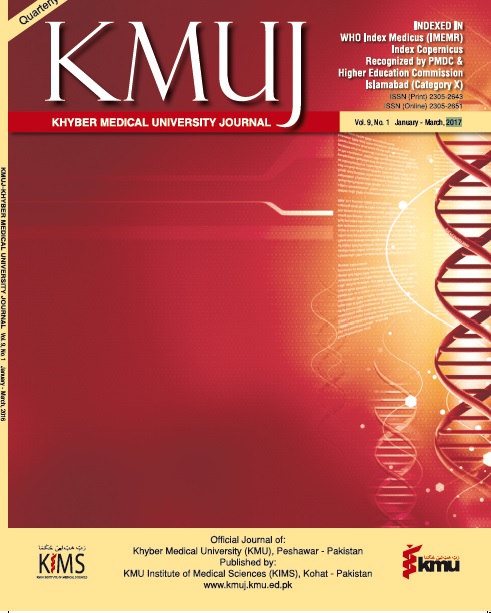ASSESSMENT AND COMPARISON OF PATIENT’S SATISFACTION WITH QUALITY OF ANTENATAL CARE SERVICES IN GYNAE OUTPATIENT DEPARTMENT OF GOVERNMENT AND PRIVATE HEALTH CARE SETTINGS
Main Article Content
Abstract
OBJECTIVES: To assess and compare patient’s satisfaction with quality of antenatal care services in gynae outpatient department of government (public sector) and private hospitals (PH).
METHODS: Study was conducted by randomly selecting 300 patients; 150 patients each from government hospitals (GH) and PH of Lahore, Pakistan, from July 2016-September 2016. A preformed “data-collection-form” was filled during interviews.
RESULTS: In our study, 107 (71.3%) patients of PH and only 29 (19.3%) patients of GH had started their antenatal care before the 3rd month pregnancy. Satisfaction with the behavior of doctors and paramedic staff was 73.3% (n=110) & 93.3% (n=140) respectively in patients going to PH as compared to 6.7% (n=10) & 86.6% (n=130) in patients attending GH, respectively. Care providers/doctors were good listener to the patient’s questions in 68.6% (n=103) of PH and 15(10%) of GH. In PH, 140 (93.33%) patients and in GH, 130 (86.67%) patients were satisfied with the time given to patient-care by healthcare provider. Family planning services were provided to 40% patients of GH and 11.3% patients of PH. In GH, majority (73.3%) of patients was followed up at one month and in PH majority (54.6%) was followed up within a week. More than three sonographs were prescribed to 33.3% patients in PH and 10% patients in GH.
CONCLUSION: Patients are more satisfied in PH because of the overall antenatal facilities, dealing of paramedical and medical staff. In GH less cleanliness, more waiting time and unsatisfactory behavior of healthcare providers makes them less satisfied for patients.
Article Details
Work published in KMUJ is licensed under a
Creative Commons Attribution 4.0 License
Authors are permitted and encouraged to post their work online (e.g., in institutional repositories or on their website) prior to and during the submission process, as it can lead to productive exchanges, as well as earlier and greater citation of published work.
(e.g., in institutional repositories or on their website) prior to and during the submission process, as it can lead to productive exchanges, as well as earlier and greater citation of published work.
References
Wylie L. Essential anatomy and physiology in maternity care. Second ed. Elsevier Health Sciences. 2005.
Sullivan TR, Hirst JE. Reducing maternal mortality: a review of progress and evidence-based strategies to achieve mil¬lennium development goal 5. Health Care Women Intl 2011;32(10):901-16.
Carroli G, Rooney C, Villar J. How effec¬tive is antenatal care in preventing mater¬nal mortality and serious morbidity? An overview of the evidence. Paediatr Perinat Epidemiol 2001;15(1):1-42.
WHO, Antenatal Care in Developing Countries: Promises, Achievements and Missed Opportunities. An Analysis of Trends, Levels and Differentials, 1990- 2001, WHO, Geneva, Switzerland, 2003.
Nwaeze IL, Enabor OO, Oluwasola TA, Aimakhu CO. Perception and Satisfaction with Quality of Antenatal Care Services among Pregnant Women at the University College Hospital, Ibadan, Nigeria. Ann Ib Postgrad Med 2013;11(1):22-8.
Joshi C, Torvaldsen S, Hodgson R, Hayen A. Factors associated with the use and quality of antenatal care in Nepal: a pop¬ulation-based study using the demographic and health survey data. BMC Pregnancy Childbirth 2014;14(1):94.
WHO, The World Health Report 2005: Make Every Mother and Child Count, World Health Organization, Geneva, Switzerland, 2005.
Simkhada B, Teijlingen ER, Porter M, Sim¬khada P. Factors affecting the utilization of antenatal care in developing countries: Systematic review of the literature. J Adv Nurs 2008:61(3):244-60.
Tsegay Y, Gebrehiwot T, Goicolea I, Edin K, Lemma H, San Sebastian M. Determinants of antenatal and delivery care utilization in Tigray region, Ethiopia: a cross-sectional study. Int J Equity Health 2013;12(1):30.
Majrooh MA, Hasnain S, Akram J, Siddiqui A, Memon ZA. Coverage and quality of antenatal care provided at primary health care facilities in the ‘Punjab’ province of ‘Pakistan’. PLoS One 2014;9(11):e113390.
Chemir F, Alemseged F, Workneh D. Satisfaction with focused antenatal care service and associated factors among pregnant women attending focused ante¬natal care at health centers in Jimma town, Jimma zone, South West Ethiopia; a facility based cross-sectional study triangulated with qualitative study. BMC Res Notes 2014;7(1):164.
Rooney C. Antenatal Care and Maternal Health: How Effective Is It? Document WHO/MSM/92A, World Health Orga¬nization, Geneva, Switzerland, 1992. [Cited on November 08, 2016]. Avail¬able from URL: http://apps.who.int/iris/ bitstream/10665/59954/1/WHO_MS-M_92.4.pdf
Cunningham FG, MacDonald PC, Gant NF. Prenatal care. In:__eds, Cunningham FG, Williams JW. Williams obstetrics (1997). 18th edition. Norwalk: Appleton and Lange.
Nisar N, Amjad R. Pattern of antenatal care provided at a public sector hospital Hyderabad Sindh. J Ayub Med Coll Abbot¬tabad. 2007;19(4):11-3.
Carroli G, Rooney C, Villar J. How effec¬tive is antenatal care in preventing mater¬nal mortality and serious morbidity? An overview of the evidence. Paediatr Perinat Epidemiol 2001;15(1):1-42.
Khan A, Zaman S. Costs of vaginal delivery and Caesarean section at a tertiary level public hospital in Islamabad, Pakistan. BMC Pregnancy Childbirth 2010;10(1):2.
Khan AA, Zahidie A, Rabbani F. Interven¬tions to reduce neonatal mortality from neonatal tetanus in low and middle income countries - a systematic review. BMC Public Health 2013;13(1):322.
Majrooh MA, Hasnain S, Akram J, Siddiqui A. A cross-sectional assessment of primary healthcare facilities for provision of antena¬tal care: calling for improvements in Basic Health Units in Punjab, Pakistan. Health Res Policy Syst 2015;13(1):s59.
Taipale P, Hiilesmaa V. Predicting delivery date by ultrasound and last menstrual period in early gestation. Obstet Gynecol 2001;97(2):189-94.
